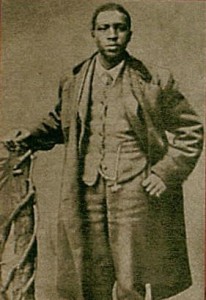African-American Jewish history: The Charoset
Charoset is a Jewish Passover dish representing the mortar that the Israelites used to make bricks while they were slaves in Egypt performing “back-breaking labor…with clay and with bricks and with all kinds of labor in the fields.” In this article from Tablet, an online daily Jewish news and culture magazine, the significance of the dish for African American Jews is interpreted.
“Passover is just around the corner, and Jews all over the world are preparing to undergo all the motions of remembering that one time, three thousand years ago when we were slaves for a little bit, then got freedom, vindication, reparations (in the form of Egyptian gold, silver, and jewelry), and—following a 40-year interlude—a country.
“For African-American Jews, however, Passover feels evermore real; tangible.
“For us, the Seder plate isn’t something symbolic of an event that happened to “ancestors” a long, long time ago in a country far, far away. It’s about experiences that happened to family—our grandparents, great-grandparents, great-great grandparents—of whom we own photographs and maybe even have had the privilege of actually knowing, in the country we still actually live in.
“If the Holy One, Blessed is He,” reads the haggadah, “Had not freed us, then we, our children, and our children’s children, would still be slaves.”
Read the entire article here.
272 Slaves Were Sold to Save Georgetown University — What Does It Owe Their Descendants?
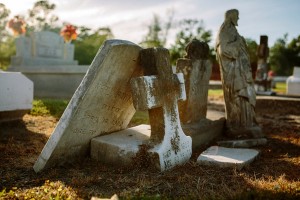
The grave of Cornelius Hawkins, one of 272 slaves sold by the Jesuits in 1838 to help keep what is now Georgetown University afloat. (NY Times)
In 1838, enslaved African-Americans belonging to the nation’s most prominent Jesuit priests were sold, along with scores of others, to help secure the future of the premier Catholic institution of higher learning at the time, known today as Georgetown University. This piece from the New York Times explores what happened and what is being done to make amends to the slaves’ descendants. Read Rachel L. Swarns’ story here in which she writes:
“Now, with racial protests roiling college campuses, an unusual collection of Georgetown professors, students, alumni and genealogists is trying to find out what happened to those 272 men, women and children. And they are confronting a particularly wrenching question: What, if anything, is owed to the descendants of slaves who were sold to help ensure the college’s survival?
“More than a dozen universities — including Brown, Columbia, Harvard and the University of Virginia — have publicly recognized their ties to slavery and the slave trade. But the 1838 slave sale organized by the Jesuits, who founded and ran Georgetown, stands out for its sheer size, historians say.”
Commentary: Horse racing’s history is complex
A Vanderbilt student and Kentucky native offers an insightful response to a column chiding the cancellation of a Kentucky Derby-themed party planned by a Dartmouth sorority because a campus Black Lives Matter group (“political correctness vigilantes”) called the event “racist and elitist.”
“Reading Bridget Bush’s “Political Correctness hits Derby,” published April 13, was deeply concerning to me. Ms. Bush responded to the decision made by Dartmouth sorority KDE to cancel their annual Derby-themed party, replacing it with a Woodstock-themed party instead.
“Her response reveals a poorly constructed historical narrative that seems to care little about the realistic development of a sport she claims to highly esteem. History informs the ways we interact with the world around us; moreover, communities are denied the opportunity for progress when they accept convenient fictions at the expense of truth. Ms. Bush’s fiction is convenient and simple; it’s black-and-white and easy to swallow. Unfortunately, her narrative omissions extend a sugar-coated interpretation of the sport’s development as a social and economic institution.”
Read more in the piece that appeared in the Louisville Courier-Journal here.
(Click image for more about Oliver Lewis.)
In Brief
April 19, 1977: Alex Haley was awarded a special Pulitzer Prize for “Roots.” His book was later transformed into an epic television mini-series seen by 130 million Americans. The finale was one of the highest rated television programs of all time.
April 20, 1871: After Congress heard testimony from witnesses of Klan atrocities in the South, President Ulysses S. Grant signed the Ku Klux Klan Act, otherwise known as the Civil Rights Act of 1871. The act gave the President the authority to suppress terrorist organizations by force and to impose harsh penalties on them. The act also gave victims the choice of going to federal courts instead of Klan-influenced local courts. In 1882, the U.S. Supreme Court declared this act unconstitutional.
April 21, 1966: Milton Olive III became the first African American to be awarded the Congressional Medal of Honor in the Vietnam War. Olive and fellow members of the 3d Platoon of Company B had been making their way through the jungles to locate Viet Cong operating in the area. As the soldiers pursued the enemy, a grenade was thrown into the middle of them. Olive grabbed the grenade and fell on it, absorbing the blast with his body. His actions saved the lives of his platoon members. Olive’s parents received the medal on his behalf.
- Read here a very moving story about Olive and the men he saved: “The Men Of Olive Company, Four Soldiers Survived Vietnam Because Milton Olive Didn’t.”
TIPHC Bookshelf
 Published scholarship on black history in Texas is growing and we’d like to share with you some suggested readings, both current and past, from some of the preeminent history scholars in Texas and beyond. We invite you to take a look at our bookshelf page — including a featured selection — and check back as the list grows. A different selection will be featured each week. We welcome suggestions and reviews. This week, in honor of his birthday, we offer, “Invisible Houston, The Black Experience in Boom and Bust,” by Robert D. Bullard.
Published scholarship on black history in Texas is growing and we’d like to share with you some suggested readings, both current and past, from some of the preeminent history scholars in Texas and beyond. We invite you to take a look at our bookshelf page — including a featured selection — and check back as the list grows. A different selection will be featured each week. We welcome suggestions and reviews. This week, in honor of his birthday, we offer, “Invisible Houston, The Black Experience in Boom and Bust,” by Robert D. Bullard.
Houston was Boomtown USA in the 1970s, growing through tremendous immigration of people and through frequent annexation of outlying areas. But in the shadow of the high-rise “petropolis” was another city ignored by and invisible to Houston municipal boosters and the national media. Black Houston, the largest black community in the South, remained largely untouched by the benefits of the boom but bore many of the burdens.
Invisible Houston describes the rich cultural history of the South’s largest black community and analyzes the contemporary issues that offer the chance for black Houston to become visible to itself, to the larger community, and to the nation.
This Week In Texas Black History, Apr. 17-23
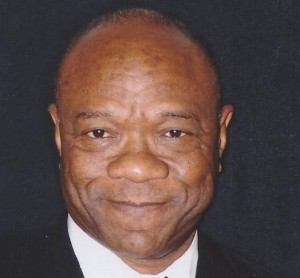 17 – Two-time All-Pro running back Delvin Williams was born on this day in 1951 in Houston. Williams graduated from Kashmere Gardens High School in
17 – Two-time All-Pro running back Delvin Williams was born on this day in 1951 in Houston. Williams graduated from Kashmere Gardens High School in
1970 and was a Parade Magazine All-American and one of the most sought after prep running backs in the country, recruited by every major college football program. Williams chose the University of Kansas and four years later became a second round pick of the San Francisco Forty-Niners. He thrived in the National Football League for eight seasons, becoming the first player in NFL history to rush for 1,000 yards in a season for two different teams (Niners and Miami Dolphins). Williams was also the first player in NFL history to set rushing records for two different teams, and to be named to the Pro Bowl for both an AFC & NFC team.
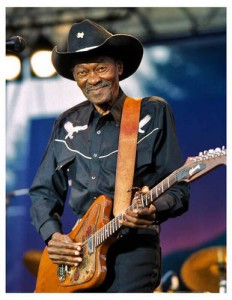 18 – On this day in 1924, Clarence “Gatemouth” Brown was born in Vinton, Louisiana. Brown was raised in Orange, Texas where he learned to play several instruments beginning with fiddle at age 5, followed by guitar, mandolin, viola, harmonica, and drums. Brown got his nickname from a high school teacher who said he had a voice “like a gate.” He made dozens of recordings in the 1940s and ’50s, including many regional hits – “Okie Dokie Stomp,” “Boogie Rambler,” and “Dirty Work at the Crossroads.” He was nominated six times for Grammy Awards and was awarded one in 1983 in the “Traditional Blues” category for his album, “Alright Again.”
18 – On this day in 1924, Clarence “Gatemouth” Brown was born in Vinton, Louisiana. Brown was raised in Orange, Texas where he learned to play several instruments beginning with fiddle at age 5, followed by guitar, mandolin, viola, harmonica, and drums. Brown got his nickname from a high school teacher who said he had a voice “like a gate.” He made dozens of recordings in the 1940s and ’50s, including many regional hits – “Okie Dokie Stomp,” “Boogie Rambler,” and “Dirty Work at the Crossroads.” He was nominated six times for Grammy Awards and was awarded one in 1983 in the “Traditional Blues” category for his album, “Alright Again.”
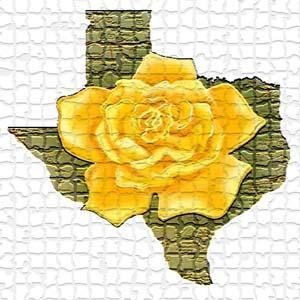 21 — This date marks the commemoration of the song The Yellow Rose of Texas. The song grew out of the Battle of San Jacinto when Texas forces led by Sam Houston defeated the Mexican troops of Gen. Santa Anna in 1836 and won Texas’ independence from Mexico. The song is a tribute to a woman (Emily West) who supposedly “entertained” the Mexican general, delaying his preparations for the battle, while the Texans successfully attacked and defeated his army in an 18-minute skirmish. However, the woman’s true identity and actual role, if any, in the battle is the subject of great debate. Generally, she is thought to have been a light-skinned mulatto, but other theories say she was Hispanic. The songs’ composer is also a mystery, though its original lyrics seem to suggest a black man:
21 — This date marks the commemoration of the song The Yellow Rose of Texas. The song grew out of the Battle of San Jacinto when Texas forces led by Sam Houston defeated the Mexican troops of Gen. Santa Anna in 1836 and won Texas’ independence from Mexico. The song is a tribute to a woman (Emily West) who supposedly “entertained” the Mexican general, delaying his preparations for the battle, while the Texans successfully attacked and defeated his army in an 18-minute skirmish. However, the woman’s true identity and actual role, if any, in the battle is the subject of great debate. Generally, she is thought to have been a light-skinned mulatto, but other theories say she was Hispanic. The songs’ composer is also a mystery, though its original lyrics seem to suggest a black man:
There’s a yellow rose in Texas
That I am going to see
No other darky (sic) knows her
No one only me
She cryed (sic) so when I left her
It like to broke my heart
And if I ever find her
We nevermore will part.
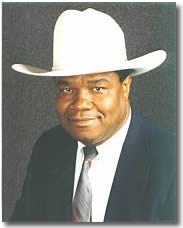 23 – On this date in 2004, Earl Pearson, then a 28-year veteran of the Texas Department of Public Safety, was named chief of the Texas Ranger Division. With his promotion, Pearson became the first black Senior Ranger Captain and the first black DPS division chief. Pearson grew up in Rotan.
23 – On this date in 2004, Earl Pearson, then a 28-year veteran of the Texas Department of Public Safety, was named chief of the Texas Ranger Division. With his promotion, Pearson became the first black Senior Ranger Captain and the first black DPS division chief. Pearson grew up in Rotan.
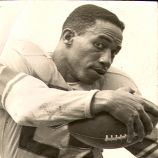 23 – On this day in 1928, black college football great Odie Posey was born in Austin. Posey, a running back, graduated from Phillis Wheatley High School in San Antonio and then attended Southern University in Baton Rouge, La. on a tennis scholarship. Posey teamed with Harold Jones in 1947 to capture the Prairie View Interscholastic League 2A Boys’ Double state championship title. At Southern, Posey became the best running back in school history. His 1,399-yards rushing total in 1949 led the nation (NCAA Division II) and still stands as the highest single-season mark in school history. During his four years at Southern, the Jaguars were 46-2-2 (undefeated, 12-0, in 1948), won three Black College National Championships, four Southwestern Athletic Conference titles and two bowl games, including the 1948 Fruit Bowl Championship against San Francisco State University. Posey was a four-time Pittsburgh Courier All-American and a four-year All-SWAC selection.
23 – On this day in 1928, black college football great Odie Posey was born in Austin. Posey, a running back, graduated from Phillis Wheatley High School in San Antonio and then attended Southern University in Baton Rouge, La. on a tennis scholarship. Posey teamed with Harold Jones in 1947 to capture the Prairie View Interscholastic League 2A Boys’ Double state championship title. At Southern, Posey became the best running back in school history. His 1,399-yards rushing total in 1949 led the nation (NCAA Division II) and still stands as the highest single-season mark in school history. During his four years at Southern, the Jaguars were 46-2-2 (undefeated, 12-0, in 1948), won three Black College National Championships, four Southwestern Athletic Conference titles and two bowl games, including the 1948 Fruit Bowl Championship against San Francisco State University. Posey was a four-time Pittsburgh Courier All-American and a four-year All-SWAC selection.
Blog: Ron Goodwin, author, PVAMU history professor
Ron Good  win’s bi-weekly blog appears exclusively for TIPHC/TBHPP. Goodwin is a San Antonio native and Air Force veteran. Generally, his column will address contemporary issues in the black community and how they relate to black history. He and the TIPHC/TBHPP staff welcome your comments. His latest blog is, “Youthful Indiscretions.” Read it
win’s bi-weekly blog appears exclusively for TIPHC/TBHPP. Goodwin is a San Antonio native and Air Force veteran. Generally, his column will address contemporary issues in the black community and how they relate to black history. He and the TIPHC/TBHPP staff welcome your comments. His latest blog is, “Youthful Indiscretions.” Read it
Submissions Wanted
Historians, scholars, students, lend us your…writings. Help us produce the most comprehensive documentation ever undertaken for the African American experience in Texas. We encourage you to contribute items about people, places, events, issues, politics/legislation, sports, entertainment, religion, etc., as general entries or essays. Our documentation is wide-ranging and diverse, and you may research and write about the subject of your interest or, to start, please consult our list of suggested biographical entries and see submission guidelines. However, all topics must be approved by TIPHC/TBHPP editors before beginning your research/writing.
We welcome your questions or comments via email or telephone – mdhurd@pvamu.edu, ![]() 936-261-9836.
936-261-9836.

